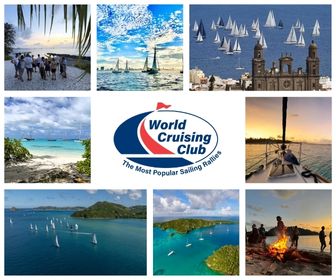Cedros and San Benitos Islands for Cruisers
Published 15 years ago, updated 7 years ago
CEDROS AND SAN BENITOS ISLANDS FOR BOATERS AND CRUISERS
Courtesy of: Cedros OUTDOOR Adventures
Brief Description: Isla de Cedros (Cedros Island)
Cedros Island, Baja’s largest Pacific coastal island is located 320 miles south of San Diego, CA, or 23 km (14 miles) north of Punta Eugenia at the tip of the Vizcaino Peninsula. It is also 110 km (62 miles) west of Guerrero Negro, the largest town of the central Baja California peninsula (15,000 +).
The two main economic activities on the 38 km long (24 miles) island are fishing and transporting salt from Guerrero Negro’s salt works (Exportadora de Sal) for worldwide shipping. Because of the salt business, Cedros’ port ranks as Mexico’s third-largest, carrying over 7 million metric tons of salt per year. Cedros Island’s population is reported as being somewhere between 1500-5,000 persons. The discrepancies may be that there are many seasonal residents, such as relatives moving in and out, visiting in summer, and those who come for the fishing season to work.
There are two main towns on Cedros Island, El Morro, and Cedros Town. The former is at the southernmost point of the island, where the employees of the salt company live in housing and infrastructure provided by the company. Cedros Town is about four times bigger; most of the inhabitants are fishermen, service providers and small business owners.
Brief Description: Islas San Benitos
San Benito Islands are a group of three small islands (East, Middle and East), which are dry and covered mostly by short bushes and a few cactus. They are situated about 16 miles west of Cedros Island. The west island is about two miles wide, with small hills and rocky shores. Only one small fishing camp is situated here on the south of the island, with about 20 houses and shacks that are used mostly during abalone and lobster season. Cargo boats take water and goods from Cedros for the fishermen, and, on returning, bring the fishing products to Cedros to be processed. The east island is almost the same size, but the hills are smaller. The middle island is half the size, flat and with not much vegetation. Around these islands, there are several submerged rocks and kelp beds, which are great for snorkelling and fishing. There is also a trail for hiking and an old lighthouse on the west island.
By boat, navigating around these islands reveals a spectacular number of elephant seals in the winter occupying every single beach. In the summer it’s the sea lions’ turn. A highlight is to visit the colony of Guadalupe Fur seal on the east island, which also reproduces in the summer months.
Other activities on these islands include snorkelling and kayaking. There are a great variety and abundance of species near the shore, the banks, and the many kelp beds. Be aware that the local fishermen cooperative (Pescadores Nacionales de Abulon) owns the rights to the abalone and lobster, and they are very protective of their resources, so don’t take any of you would risk several consequences. During their respective fishing season, there is the possibility to buy some canned abalone or lobster from them.
The Towns and Services
At Cedros town, there is the main street, recently paved, leading from the harbour, as well as other paved side streets. In this town you can find diverse services and goods including the offices of the fishing co-op which runs a cannery, a couple of small grocery stores, (beer and liquor, limited selection of foods, mostly dried and canned, with produce and ice especially hard to come by), a couple of cafes and two restaurants. El Marino and La Placentia serve breakfasts, good Mexican food and seafood in the local styles: breaded and fried, grilled, or sautéed with butter and garlic. There are also taco stands, burritos, and hotdogs on vending cars at night. Food, snacks, beer and liquor can be purchased in local stores.
Also on the island there are two churches, schools, a family-friendly pool hall, pharmacy, an airport serving various destinations in Baja California, a gift shop, a clean, new hotel with internet service, hot showers and satellite TV, a guest house owned by the fishing co-op, and a sizable residential area. Land phones are found in almost every home, and cell phones work on the southwest region of the island. Government representatives and other authorities are present on the island, including police, immigration, army and navy quarters, customs, port captain, and county representative, as well as a fishing and environmental representative. There are no ATMs or banks on the island, but those who have not had the opportunity to buy pesos can use U.S. dollars, in most of the businesses at a fair rate.
South of this town, about 5 miles away is El Morro town and the docks where salt from Guerrero is off-loaded. It is an impressive operation with huge machinery and manoeuvres that are worth seeing. Tours can be arranged. In between these towns are a cannery and the food processing plant of the fishing cooperative where abalone is canned, lobster is packed, and other seafood is processed and sold worldwide. Also, there is a small laboratory, which focuses on producing abalone “seeds” to be placed in suitable areas to replace the abalone on harvested sites.
Be aware that gasoline, diesel, and aeroplane fuel is not sold regularly here, so it is recommended to inquire in advance if you foresee the need of it. As an option, the nearby town of Bahia Tortugas (37 miles south on the Baja California peninsula) has a regular supply of gasoline and diesel.
Nobody lives on San Benitos Islands full-time, though up to 70 people live in the small camp on the west island during abalone season. The cooperative maintains 4-6 “vigilantes” permanently who make regular outings at night to look for abalone and lobster poachers, who can make a lot of money in one night illegally selling these valuable species, but who also hurt the well-managed resources which are the exclusive rights of the local fishing cooperative.
Accommodations and Camping
There is a guest house managed by the fishing cooperative with capacity for about 20 people, and a modern hotel with satellite TV, restaurant, internet and a patio. Dry camping (no facilities) is also possible anywhere on the island. Our only recommendation is to be aware of the endemic rattlesnake, which is still abundant on the island during summer months.
Weather
The temperature and weather of this island are excellent. The summer temperatures are mildly warm, rarely above 90 F at any time, low humidity. The average is around 80 F during the day in the summer. In the winter the temperature seldom goes below 40 F. Generally it stays in the range of 50s to 70s. The rainy season is during winter, but even then precipitation is very scarce. For visitors we recommend the summer months when the water temperatures are best to swim, boat, kayak, hike, or just relax in town. You will notice that there is no AC in any of the houses of the town, and with the cool Pacific breezes, it is not needed.
Conservation of islands and working with locals
Islands are very unique environments and the impact caused by human activities and exotic species has been the cause of most wildlife extinctions in the world. One objective of Cedros Outdoor Adventures is to promote environmentally low-impact economic activities in remote island communities. By joining us on one of our trips, you will be helping to maintain the natural balance of the islands. In exchange, visitors are rewarded with a great experience of authentic Mexican wildlife and culture.
How it works: We hire locals to perform many services, we use local hotels, eat in local restaurants, etc. We also work with these local vendors, teaching them about the expectations and needs of tourists, and about the importance of environmentally-sustainable tourism. It has been proven in this community, as well as others, that when the locals experience the economic and environmental benefits of these practices in action, they become committed to sustainable methods of earning a living and protecting their island’s eco-system. We are also happy to provide help and information for travellers interested in learning more about other islands of the region such as Natividad, Guadalupe, San Jeronimo, San Martin, Asuncion and San Roque on the Pacific coast of Baja.
Our thanks to Jose Angel Sanchez-Pacheco of Cedros OUTDOOR Adventures for sending noonsite this information.
E-mail: cedrosisland@hotmail.com
www.cedrosoutdooradventures.com
ph 619 793 5419
Related to following destinations: Cedros Island, Mexico, West Coast (Mexico)





